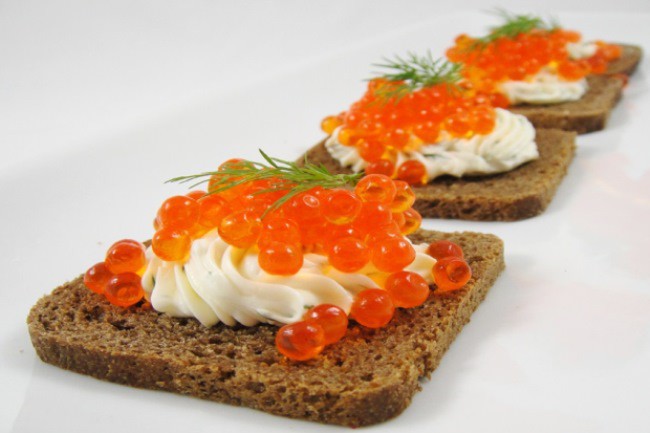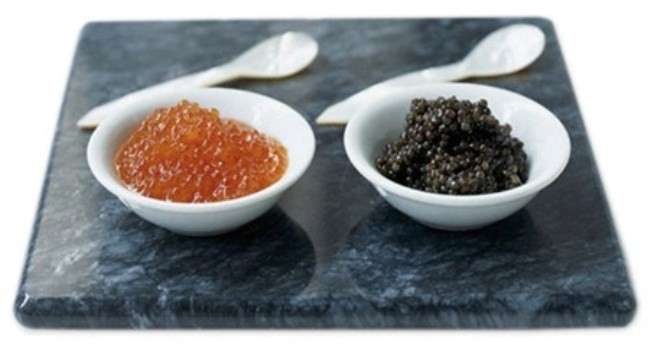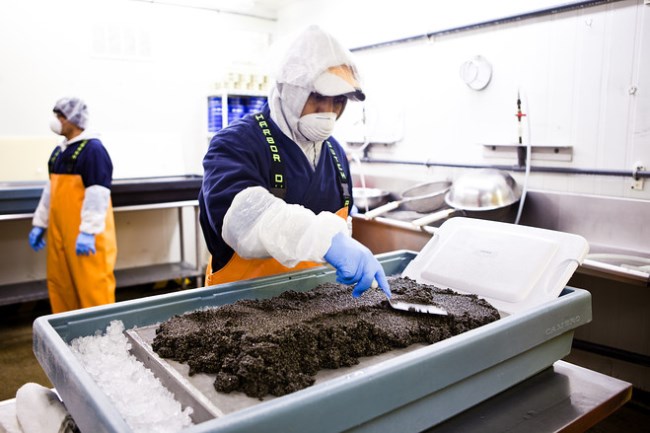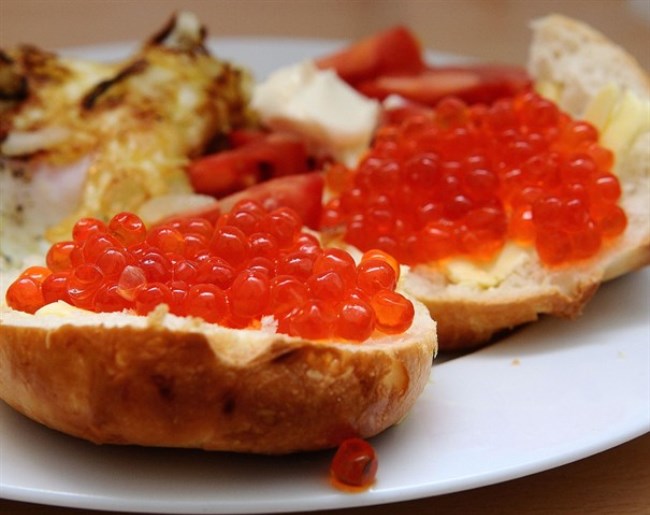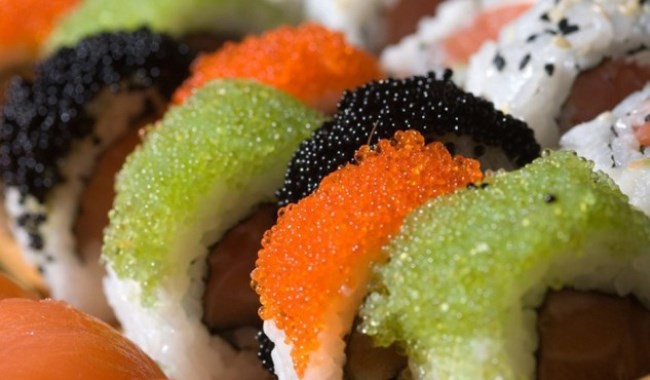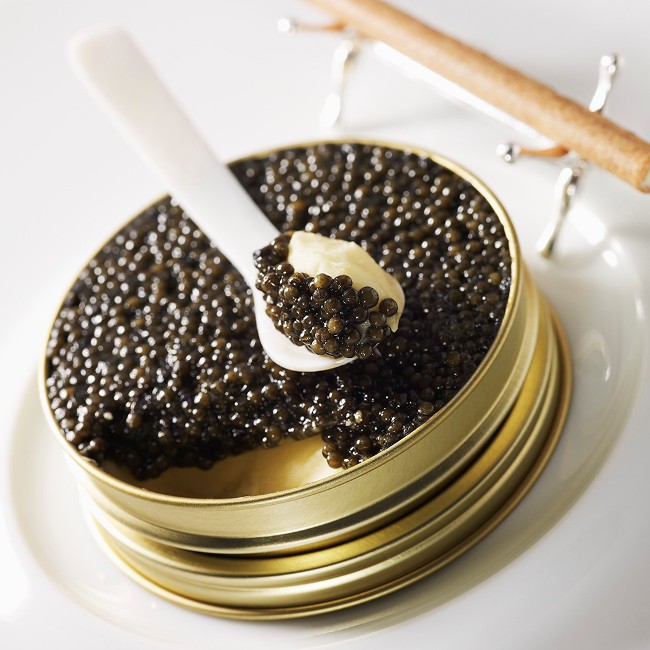(kav-ee-ahr) the roe of sturgeon, especially the beluga, or other fish, usually served as hors d’oeuvre or appetizer
ORIGINS
In ancient times, Persian nobles were believed to be the first people who had a penchant for caviar. Wealthy Greeks would also indulge in this delicacy at their extravagant banquets. Subsequently, the Russian tsars were known to be wildly passionate about this delicate roe.
The Russian word for caviar is ‘ikra’ and the best grade of caviar is ‘malossol’, which means ‘lightly salted’. Astrakhan, a city on the banks of the Volga River in southern European Russia, is widely acknowledged as the most important city in caviar history. Though the word ‘caviar’ has often been associated with Russia, the word ‘caviar’ entered the English vernacular in the 16th century and is believed to have been borrowed from the Turkish word ‘havyar’.
Caviar has no proven medicinal properties though the Persians were known to have consumed it in stick form to give them energy and stamina. During the 19th century, word has it that caviar could strengthen sexual desire, based on findings in a health manual released in 1806, which claimed that caviar could “excite the blood”.
WHAT IS CAVIAR
Twenty four species of sturgeons are found in various countries, including Russia (from Siberia to Volga River and the Caspian Sea), Iran and Romania. However, only three species supply caviar: the Beluga, Russian and Stellate sturgeons. The most sought-after caviar comes from the Caspian Sea, incidentally the world’s largest supply of caviar, because of the quality of the eggs.
Smaller than Beluga, the Russian sturgeon’s eggs, which give us the Ossetra caviar, are grey to light-brown in color and have a nutty flavor. The golden Ossetra, a rare form of Ossetra caviar, is gold-yellow in color and has a very rich flavor. The tiniest of the three, Sevruga caviar, from the grey-black roes of the Stellate sturgeon, are fine and distinctively salty.
HOW IS IT PRODUCED
When left alone in their natural habitat, sturgeons are more fertile. After they are caught, the eggs are removed and then carefully sieved through a fine mesh screen. This is done to separate the eggs and discard any excess fatty tissues and membrane. About 5 percent salt is added to preserve the eggs and enhance the flavor (this is a traditional method which is still used today). The eggs are then cured in brine for several weeks.
There are two grades of caviar. Grade one consists of intact eggs while grade 2 consists of more than 50 percent broken or soft eggs. Caviar contains about 52 percent water, 28 percent protein, 16 percent fat, 1.5 percent sugar, 1.0 percent vitamins and trace constituents. Apart from preserving caviar with a minimal amount of salt, there are two other ways of processing the roe:
– Pasteurizing: The roe is partially cooked so that it has a longer shelf life. The texture of the roe will become firmer after pasteurization.
– Pressed: After the sieving process, some of the eggs that are broken will be treated, salted and pressed. The texture is similar to jam and the taste is rich.
Demand for these shiny fine-grained morsels increased with the growth in global markets. Once reserved for the elite, this delicacy is now easily available, hence the reduction in supply. These days, the population of sturgeons (Beluga, in particular) has been decreasing as a result of pollution, poaching and over-fishing. Their scarcity is further exacerbated as it takes up to two decades for the female sturgeon to mature and produce eggs.
CAVIAR DISHES
Caviar is often eaten cold, on its own or used as a garnish. If caviar is added to a dish, make sure the flavor is not overwhelmed by the other ingredients. Do not cook caviar as it will become tough and unpalatable.
Typically, caviar is served on blinis (pancakes – a very Russian way of eating caviar) with a dollop of sour cream or crème fraiche. Many chefs like to serve it simply with chopped eggs, so that the rich taste of the caviar takes center-stage. Caviar can also be paired with seafood, served in carpaccio. This way the saltiness of the caviar makes up for the lack of seasoning to achieve a delectable balance. As concerns over the diminishing population of the Beluga sturgeon increase, avruga caviar, made from the roe of herring, is increasing in popularity and is seen as a more sustainable alternative to Beluga caviar.
TIPS ON HOW TO HANDLE CAVIAR
Spoon the roe with a non-metallic utensil such as a plastic, wooden or glass spoon. Stainless steel or silver spoons will easily oxidize and give an unfavorable metallic taste to the delicate eggs. Traditionally, a mother-of-pearl or gold spoon is used.

